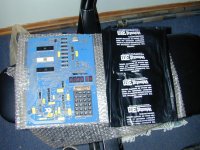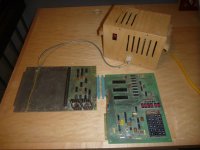Hi,
So far so good.
Yep, checking for a short across the power supply lines with an Ohmmeter is a pretty good way to start out. I don't think that I explained too well about the current consumption though. Your 2A power supply can supply a maximum of 2A at 5V under normal circumstances. Your unexpanded KIM should draw nothing like that current under normal circumstances! An excessively high current drawn from the power supply (especially with none of the LED displays lit) could indicate faulty components (e.g. leaky capacitors that may not have been detected by your Ohmmeter test and/or faulty semiconductor devices). Since you have another KIM as a reference, I would suggest measuring the current drawn from the 5V supply with your working KIM and then measure the current drawn from the 5V supply with your faulty KIM. The faulty KIM should draw less current than your healthy KIM (as the displays are not working). If the faulty KIM draws a larger current than your working KIM then this is not normal and the reason for it determined before continuing. In this case I would be tempted to keep the powered up times to a minimum.
It's great that you seem to have a working reset circuit and clock to start off with - and good news to hear that you have an oscilloscope!
I would proceed by following the clock circuit now we have seen something on U1 pins 3 and 39. Check U16 (7404) pins 13, 12, 11 and 10. They all should have a clock on them as well.
Next I would look at the 6502 address bus (especially A0 and A1). Do you see any logic changes here or not? If not - this probably indicates that the 6502 is not processing any instructions. It may be faulty, it may not be faulty. It depends on other signals being fed to the 6502.
Next I would look at U4 (74145). The 'D' input should be permanently '0' (this is our DECEN link that we identified before). You should see some activity on the A, B and/or C inputs. These are tied to some of the higher address lines of the 6502 CPU. If you see nothing on the address lines it is back to the CPU again. Continue to look at the K0, K5, K6 and K7 outputs from U4. These signals should normally be high but should 'flick' low briefly as the 6502 addresses the ROM, RAM and I/O. K0 addresses the on-board RAM. K5 addresses the I/O and K6/K7 address the ROM. You should see activity on K5. I would think there is a high probability of seeing activity on K0 and you should see activity on either K6 or K7 or both depending upon what part of the ROM is executing. You could (of course) compare what you are seeing on your faulty unit with your good one...
If this checks out OK - I would then look at the display section. I assume from the photograph that U2 is not in a socket and is soldered into the PCB? If so - proceed as follows (but ONLY if you understand what I am saying):
1) Connect a resistor of 1KOhm between the base of transistor Q1 and ground. This should enable transistor Q1 and the emitter of Q1 (connected to the first LED display - U18) should go to 5V.
2) Connect U17A (7406) pin 2 to ground.
Incidentally, the schematic I am using can be found here
http://www.zimmers.net/anonftp/pub/cbm/schematics/kim-1/kim.gif
Segment 'A" of display U18 should illuminate.
Remove the link from U17A pin 2. The segment should be extinguished.
Repeat by linking each of the six outputs in turn from U17 to ground (plus the output from U26A pin 3). Each of the other segments in turn should light up.
WARNING: Resistors R26 to R32 are there to limit the current flow through the segment of the display device. Grounding the wrong side of the resistor will cause an excessive current through the display and would destroy it.
Move the link from the base of Q1 to the base of Q2 and so forth to test all of the other displays in turn.
This should prove whether the displays (and the transistors that drive them) are working.
I would like someone to check what I have said above before you perform this procedure just in case I have made some errors somewhere... The last thing I want to do is to tell you to do something that will further damage your new pride and joy!
That's probably enough for now...
Dave



